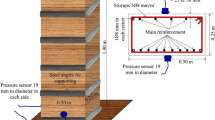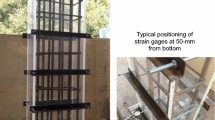Abstract
In this work, we propose to extend the Ovarlez and Roussel model, for estimating lateral form pressure exerted by fresh concrete, to low casting rates and long duration formwork filling. In this case, the assumption of a linear increase of the concrete yield stress with time at rest is imprecise. This assumption is valid for approximately 1 h at rest after placing and may lead to an overestimation of the lateral pressure for a longer period. Based on chemical arguments and experimental observations, it has been shown that the yield stress increases exponentially over time. The same fundamental physical assumptions made by Ovarlez and Roussel are used to predict the lateral pressure exerted on formwork. Comparison of the proposed model with experimental measurements shows that, pressure can be predicted with an accuracy comparable to the Ovarlez and Roussel model for casting times less than 1 h.






Similar content being viewed by others
References
Billberg PH, Roussel N, Amziane S, Beitzel M, Charitou G, Freund B, Gardner JN, Grampeix G, Graubner C, Keller L, Khayat KH, Lange DA, Omran AF, Perrot A, Proske T, Quattrociocchi R, Vanhove Y (2014) Field validation of models for predicting lateral form pressure exerted by SCC, Cement and Concrete Composites
Proske T, Graubner C-A (2007) Pressure on formwork using SCC—Experimental studies and modeling. Fifth RILEM international symposium on Self-Compacting Concrete, Ghent
Khayat KH, Omran AF (2011) Field monitoring of SCC formwork pressure and validation of prediction models. J Concr Int 33:33–39
Perrot A, Amziane S, Ovarlez G, Roussel N (2009) SCC formwork pressure: influence of steel rebars. Cem Concr Res 39:524–528
Tchamba JC, Amziane S, Ovarlez G, Roussel N (2008) Lateral stress exerted by fresh cement paste on formwork: laboratory experiments. Cem Concr Res 38:459–466
Ovarlez G, Roussel N (2006) A physical model for the prediction of lateral stress exerted by self-compacting concrete on formwork. Mater Struct 39:269–279
Gardner JN, Keller L, Quattrociocchi R, Charitou G (2012) Field investigation of formwork pressure using self-compacting concrete. Concr Int 34:41–47
Lange DA, Birsch B, Henschen J, Lieu Y-S, Struble T-DFL (2008) Modeling formwork pressure of SCC. In: Shah ESP (ed) 3rd North American Conference on the design and use of Self-compacting concrete, Chicago, pp 295–300
Graubner C-A, Boska E, Motzko C, Proske T, Dehn F (2012) Formwork pressure induced by highly flowable concrete—design approach and transfer in practice, Structural concrete journal of the FIB 1
Beitzel M (2010) Modeling fresh concrete pressure of normal and self-compacting concrete. In: Khayat KH, Feys D Sixth RILEM international symposium on SCC, Fourth American conference on the design and use of self-compacting concrete, Montreal, pp 243–254
Billberg PH (2003) Form pressure generated by self-compacting concrete 3rd international RILEM symposium on Self-Compacting Concrete Reykjavik, Island, pp 271–280
Assaad J, Khayat KH (2003) Variation of formwork pressure with thixotropy of self-consolidating concrete. ACI Mater J 100:29–37
Lecompte T, Perrot A, Picandet V, Bellegou H, Amziane S (2011) Cement-based mixes: shearing properties and pore pressure. Cem Concr Res 42:139–147
Roussel N (2005) Steady and transient flow behaviour of fresh cement pastes. Cem Concr Res 35:1656–1664
Roussel N (2006) A thixotropy model for fresh fluid concretes: theory, validation and applications. Cem Concr Res 36:1797–1806
Lootens D, Jousset P, Martinie L, Roussel N, Flatt RJ (2009) Yield stress during setting of cement pastes from penetration tests. Cem Concr Res 39:401–408
Sleiman H, Perrot A, Amziane S (2010) A new look at the measurement of cementitious paste setting by Vicat test. Cem Concr Res 40:681–686
Mahaut F, Mokeddem S, Chateau X, Roussel N, Ovarlez G (2008) Effect of coarse particle volume fraction on the yield stress and thixotropy of cementitious materials. Cem Concr Res 38:1276–1285
Perrot A, Lecompte T, Khelifi H, Brumaud C, Hot J, Roussel N (2012) Yield stress and bleeding of fresh cement pastes. Cem Concr Res 42:937–944
Perrot A, Lecompte T, Estellé P, Amziane S (2013) Structural build-up of rigid fiber reinforced cement-based materials. Mater Struct 46(9):1561–1568
Khayat KH, Omran AF, Naji S, Billberg P, Yahia A (2012) Field-oriented test methods to evaluate structural build-up at rest of flowable mortar and concrete. Mater Struct 45:1547–1564
Khayat K, Assaad J, Mesbah H, Lessard M (2005) Effect of section width and casting rate on variations of formwork pressure of self-consolidating concrete. Mater Struct 38:73–78
Assaad J, Khayat K (2006) Effect of casting rate and concrete temperature on formwork pressure of self-consolidating concrete. Mater Struct 39:333–341
Khayat K, Assaad J (2008) Measurement systems for determining formwork pressure of highly-flowable concrete. Mater Struct 41:37–46
Amziane S (2006) Setting time determination of cementitious materials based on measurements of the hydraulic pressure variations. Cem Concr Res 36:295–304
Andriamanantsilavo NR, Amziane S (2004) Maturation of fresh cement paste within 1- to 10-m-large formworks. Cem Concr Res 34:2141–2152
Assaad J, Khayat KH (2004) Variation of lateral and pore water pressure of self compacting concrete at early age. ACI Mater J 101:310–317
Keller H, Plank J (2013) Mineralisation of CaCO3 in the presence of polycarboxylate comb polymers. Cem Concr Res 54:1–11
Roussel N, Ovarlez G, Garrault S, Brumaud C (2012) The origins of thixotropy of fresh cement pastes. Cem Concr Res 42:148–157
Wallevik JE (2009) Rheological properties of cement paste: thixotropic behaviour and structural breakdown. Cem Concr Res 39:14–29
Subramaniam KV, Wang X (2010) An investigation of microstructure evolution in cement paste through setting using ultrasonic and rheological measurements. Cem Concr Res 40:33–44
Author information
Authors and Affiliations
Corresponding author
Rights and permissions
About this article
Cite this article
Perrot, A., Pierre, A., Vitaloni, S. et al. Prediction of lateral form pressure exerted by concrete at low casting rates. Mater Struct 48, 2315–2322 (2015). https://doi.org/10.1617/s11527-014-0313-8
Received:
Accepted:
Published:
Issue Date:
DOI: https://doi.org/10.1617/s11527-014-0313-8




